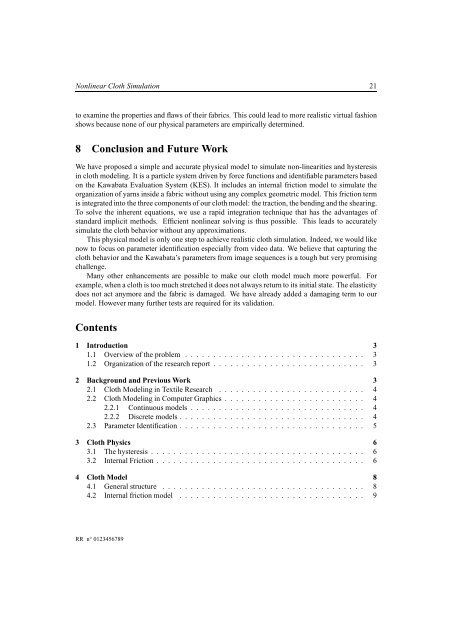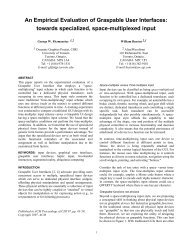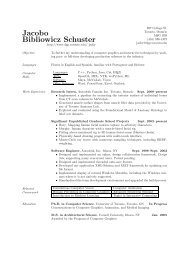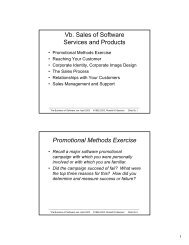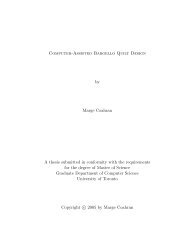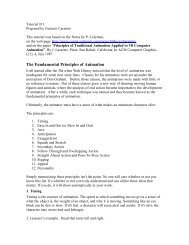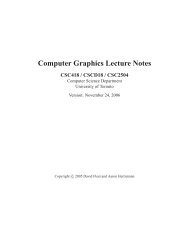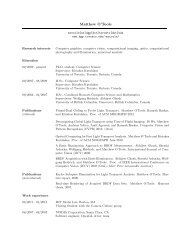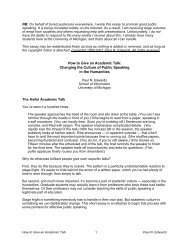Nonlinear Cloth Simulation - dgp
Nonlinear Cloth Simulation - dgp
Nonlinear Cloth Simulation - dgp
You also want an ePaper? Increase the reach of your titles
YUMPU automatically turns print PDFs into web optimized ePapers that Google loves.
<strong>Nonlinear</strong> <strong>Cloth</strong> <strong>Simulation</strong> 21<br />
to examine the properties and flaws of their fabrics. This could lead to more realistic virtual fashion<br />
shows because none of our physical parameters are empirically determined.<br />
8 Conclusion and Future Work<br />
We have proposed a simple and accurate physical model to simulate non-linearities and hysteresis<br />
in cloth modeling. It is a particle system driven by force functions and identifiable parameters based<br />
on the Kawabata Evaluation System (KES). It includes an internal friction model to simulate the<br />
organization of yarns inside a fabric without using any complex geometric model. This friction term<br />
is integrated into the three components of our cloth model: the traction, the bending and the shearing.<br />
To solve the inherent equations, we use a rapid integration technique that has the advantages of<br />
standard implicit methods. Efficient nonlinear solving is thus possible. This leads to accurately<br />
simulate the cloth behavior without any approximations.<br />
This physical model is only one step to achieve realistic cloth simulation. Indeed, we would like<br />
now to focus on parameter identification especially from video data. We believe that capturing the<br />
cloth behavior and the Kawabata’s parameters from image sequences is a tough but very promising<br />
challenge.<br />
Many other enhancements are possible to make our cloth model much more powerful. For<br />
example, when a cloth is too much stretched it does not always return to its initial state. The elasticity<br />
does not act anymore and the fabric is damaged. We have already added a damaging term to our<br />
model. However many further tests are required for its validation.<br />
Contents<br />
1 Introduction 3<br />
1.1 Overview of the problem . . . . . . . . . . . . . . . . . . . . . . . . . . . . . . . . 3<br />
1.2 Organization of the research report . . . . . . . . . . . . . . . . . . . . . . . . . . . 3<br />
2 Background and Previous Work 3<br />
2.1 <strong>Cloth</strong> Modeling in Textile Research . . . . . . . . . . . . . . . . . . . . . . . . . . 4<br />
2.2 <strong>Cloth</strong> Modeling in Computer Graphics . . . . . . . . . . . . . . . . . . . . . . . . . 4<br />
2.2.1 Continuous models . . . . . . . . . . . . . . . . . . . . . . . . . . . . . . . 4<br />
2.2.2 Discrete models . . . . . . . . . . . . . . . . . . . . . . . . . . . . . . . . . 4<br />
2.3 Parameter Identification . . . . . . . . . . . . . . . . . . . . . . . . . . . . . . . . . 5<br />
3 <strong>Cloth</strong> Physics 6<br />
3.1 The hysteresis . . . . . . . . . . . . . . . . . . . . . . . . . . . . . . . . . . . . . . 6<br />
3.2 Internal Friction . . . . . . . . . . . . . . . . . . . . . . . . . . . . . . . . . . . . . 6<br />
4 <strong>Cloth</strong> Model 8<br />
4.1 General structure . . . . . . . . . . . . . . . . . . . . . . . . . . . . . . . . . . . . 8<br />
4.2 Internal friction model . . . . . . . . . . . . . . . . . . . . . . . . . . . . . . . . . 9<br />
RR n° 0123456789


